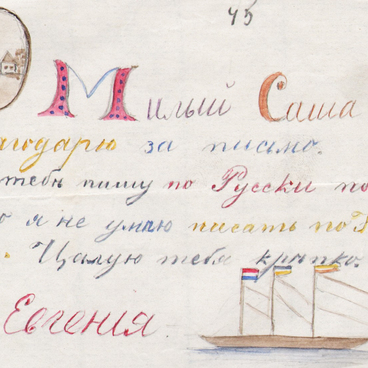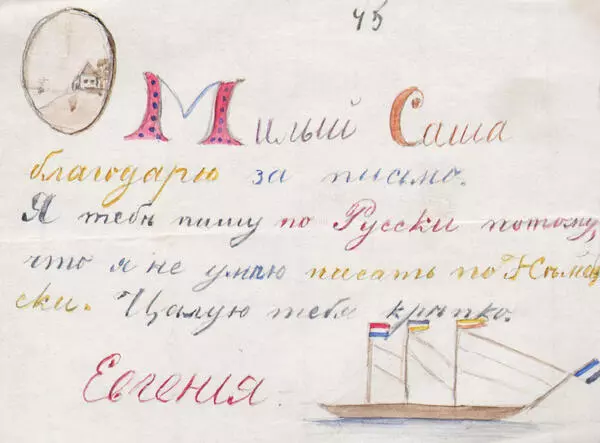Coffered ceiling is a special type of covering, which consists of recesses, beams and cells of various shapes. In the old days, recesses in ceiling tiles were decorated with intricate decorative carvings, and their surface was covered with gilding. That design made it possible to make the ceiling visually higher.
The fragment of the ceiling covering kept in the Palace Complex of the Oldenburgs is a square wooden plate with a floral pattern applied by pyrography or burning. In the late 19th and early 20th centuries, that hobby became very popular among aristocrats. A new device for pyrography was invented at the same time. The following description was attached to it: ‘The Paquelin device consists of a flask covered with a stopper, with two holes, to which rubber tubes are attached, ending on one side with a double rubber ball for blowing air into it (one, thick-walled, ball is equipped with valves, and the other — thin-walled is covered with a mesh and serves as a reservoir of compressed air drawn into it when the first ball is squeezed), and on the other — with a platinum tip screwed into a wooden handle. The flask is half filled with gasoline; one holds in his right hand a platinum tip by a wooden handle and heats it on an alcohol lamp until it becomes red hot, and lightly and evenly presses a thick-walled rubber ball with the left hand). Air is blown into the flask, gasoline vapors are mixed with air and, after passing through a rubber tube, they enter the platinum tip through a small hole inside the tip, and, when burning, retain the force of fire in it. When the rubber ball is not squeezed anymore, the fire burns out and the tip becomes cold soon. That hot tip is used as a pencil or a feather and is applied to burn various pictures on wood. At first, it is very difficult to get used to a very hot tip, but with a known skill and art it is possible to regulate the strength of the fire, increasing the incandescence where strong effects, sharp contours are needed and where it is necessary to burn deeper, and moderating it for fine lines and light shades or partial shades. Thicker or thinner tips are used for the same purpose.’
The presented fragment was part of the coffered ceiling of the Ramon Palace’s library. The coffered ceiling of the library was covered with smooth wooden plates — larger octagonal and smaller square ones, on the surface of which the princess herself burnt the heraldic symbols of the Oldenburg, drawings based on the motives of ancient Greek myths and the text on the back of the panels: “1887, February, March, April, May. Pictures were prepared by A.M. Abel. Burnt by Eugenia, the princess of Oldenburg. The background was made by maid of honor A.D. Shipova, Colonel A.Ch. Ganicke.”
The fragment of the ceiling covering kept in the Palace Complex of the Oldenburgs is a square wooden plate with a floral pattern applied by pyrography or burning. In the late 19th and early 20th centuries, that hobby became very popular among aristocrats. A new device for pyrography was invented at the same time. The following description was attached to it: ‘The Paquelin device consists of a flask covered with a stopper, with two holes, to which rubber tubes are attached, ending on one side with a double rubber ball for blowing air into it (one, thick-walled, ball is equipped with valves, and the other — thin-walled is covered with a mesh and serves as a reservoir of compressed air drawn into it when the first ball is squeezed), and on the other — with a platinum tip screwed into a wooden handle. The flask is half filled with gasoline; one holds in his right hand a platinum tip by a wooden handle and heats it on an alcohol lamp until it becomes red hot, and lightly and evenly presses a thick-walled rubber ball with the left hand). Air is blown into the flask, gasoline vapors are mixed with air and, after passing through a rubber tube, they enter the platinum tip through a small hole inside the tip, and, when burning, retain the force of fire in it. When the rubber ball is not squeezed anymore, the fire burns out and the tip becomes cold soon. That hot tip is used as a pencil or a feather and is applied to burn various pictures on wood. At first, it is very difficult to get used to a very hot tip, but with a known skill and art it is possible to regulate the strength of the fire, increasing the incandescence where strong effects, sharp contours are needed and where it is necessary to burn deeper, and moderating it for fine lines and light shades or partial shades. Thicker or thinner tips are used for the same purpose.’
The presented fragment was part of the coffered ceiling of the Ramon Palace’s library. The coffered ceiling of the library was covered with smooth wooden plates — larger octagonal and smaller square ones, on the surface of which the princess herself burnt the heraldic symbols of the Oldenburg, drawings based on the motives of ancient Greek myths and the text on the back of the panels: “1887, February, March, April, May. Pictures were prepared by A.M. Abel. Burnt by Eugenia, the princess of Oldenburg. The background was made by maid of honor A.D. Shipova, Colonel A.Ch. Ganicke.”




